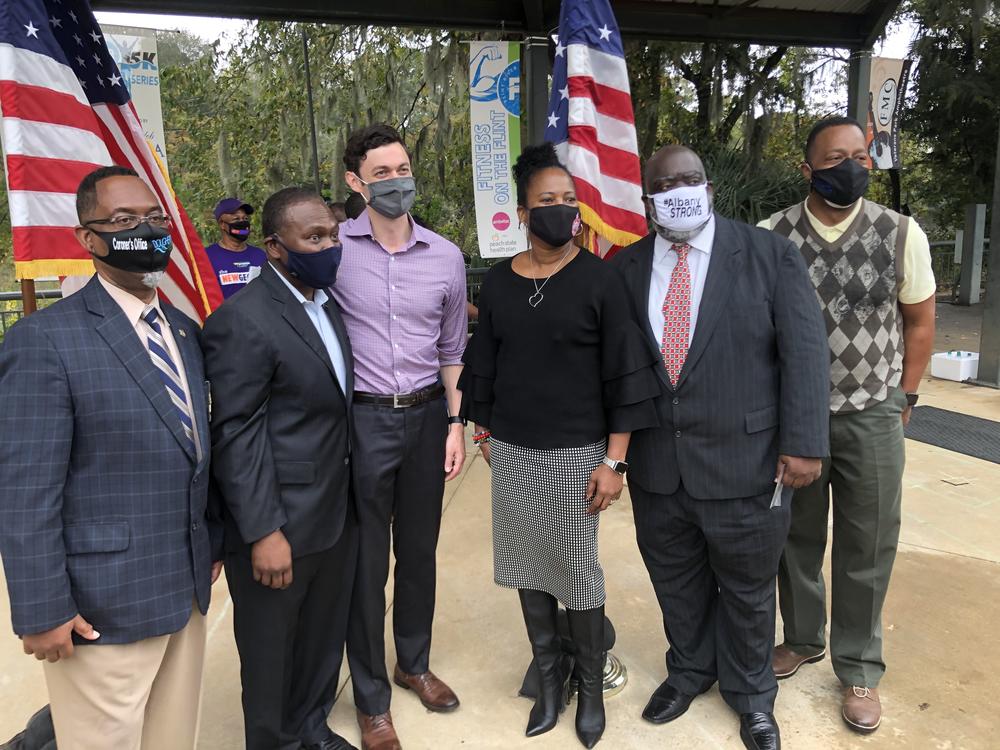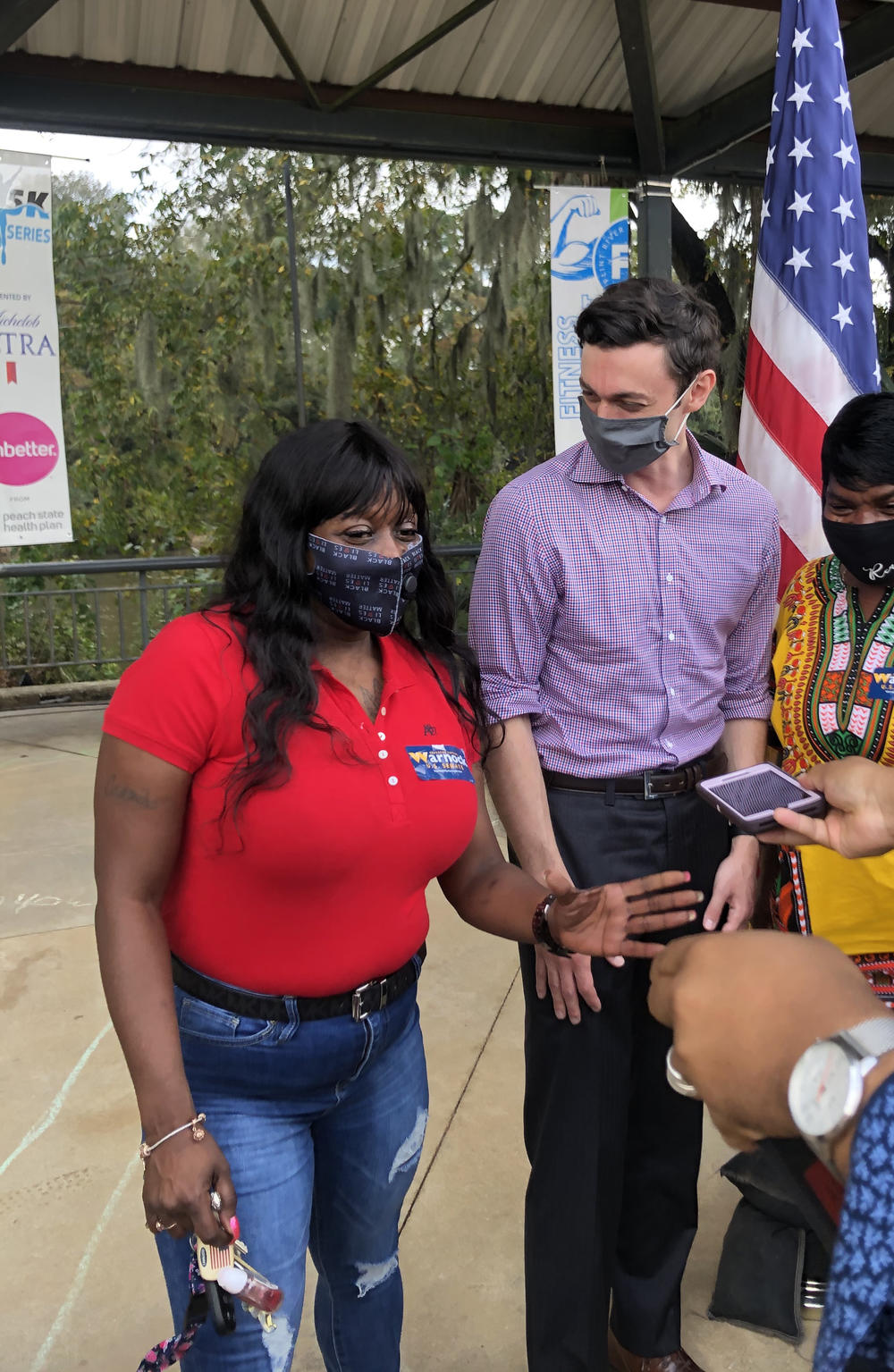
Caption
From left: Michael Fowler, Winfred Dukes, Jon Ossoff, CaMia Hopson, Demetrius Young, and Derrick Jackson pose during Ossoff's visit to Albany on the U.S. Senate campaign in 2020.
Credit: Brad Bailey

From left: Michael Fowler, Winfred Dukes, Jon Ossoff, CaMia Hopson, Demetrius Young, and Derrick Jackson pose during Ossoff's visit to Albany on the U.S. Senate campaign in 2020.
“We didn't just show up; we showed out — and Georgia shocked the world.”
So said Georgia state Rep. Winfred Dukes of the November election during a December campaign speech in Albany for U.S. Senate candidate Jon Ossoff.
“Now listen, we have a little more business left to do,” Dukes continued. “We are going to show not only the people of Georgia … but the entire nation what the people of Georgia are all about.”
Although Atlanta may be the state’s population center, historically it’s the voters of rural Georgia who decide the winner of statewide elections. Dukes, a Democrat who represents the state’s District 154, is keenly aware of this, and is highlighting ways to bring more political attention to southwest Georgia and its proverbial “Black Belt.”
Dukes’ message reflects the attitude of rural Democrats statewide: Atlanta and its suburbs played a huge role, but so did we.
The term Black Belt, popularized by early 20th-century civil rights activist Booker T. Washington, stands for an 11-state area where a large majority of Black people live in the South. In Georgia, these predominantly rural counties where African Americans comprise 40 percent of the population in a wide swath of the state’s central and southern regions.
On election night, it was the votes of Albany and the surrounding Black Belt, in which President-elect Joe Biden took nearly 70% of the vote, that contributed to Biden’s narrow win over President Donald Trump in Georgia’s final vote tally.
As crucial as these votes were in the general election, it just may come down to these counties again in the runoff election on Jan. 5. Ossoff faces incumbent Republican Sen. David Perdue, while the Rev. Raphael Warnock is challenging GOP Sen. Kelly Loeffler.
The election will determine control of the U.S. Senate.
Dukes represents a district stretching from Albany southwest to the Alabama border. Many of Dukes' constituents live in rural, predominantly African American areas surrounding Albany. Although special elections generally have a significantly lower turnout than general elections, Dukes believes many more votes will be needed to win this unique election.
“In Albany, we need a 75% turnout,” Dukes said. “That means you got to go and get your friends, your neighbors, your children, and everybody who you know, to come forth and participate in this election because this is one of the most important elections in our lifetime. And I know you can do it, because you've done it before.”
Many residents feel that the rural counties south of Macon have been overlooked by the national Democratic establishment, and that in order to secure Georgia’s political future, attention must be paid to their concerns. Georgia is a bellwether for formerly “red” states nationwide that are undergoing seismic demographic shifts, skewing toward a younger, more diverse electorate. In many ways, these rural Georgia Black voters are a “sleeping giant” and could affect Georgia’s political stances for decades.
Although Atlanta has had a predominantly African American power structure since the 1970s, there has never been an African American governor or senator in Georgia’s history. Notable runs for statewide posts were Andrew Young and more recently, Stacey Abrams — and now Warnock.
Historically, it has been the power of votes outside of Atlanta that have decided state elections due to consistently high turnout from conservative and predominantly white, evangelical voters.
But the November general election changed everything, with the diverse voters around Atlanta and the Black rural voters jolting the political establishment to hand Biden a victory, the first time the state has voted for a Democratic president since 1992.
In a phone conversation while driving from Atlanta to Albany, Dukes addressed the differences between politics in Atlanta and the rural areas — and the need for different strategies to get out the vote.
Dukes said the rapidly evolving nature of Atlanta’s population makes campaigning different than rural areas where populations are more permanent. He believes that the “metro mechanism” for getting out the vote doesn’t apply in rural Georgia.
“You have to find a way to go through the existing infrastructure that’s in place,” he said. “We have an infrastructure in South Georgia. It’s based on years of relationships.”
Dukes believes that rural counties rely on longstanding relationships, and campaigns must engage local political and community entities that are the bedrock of these counties.
“They know your family,” he said, “They know you. They know your parents. They know your children. They see you in church on Sundays.”
Dukes said that older voters rely on word of mouth.
“The two weeks before the election, they would get on the telephone and start talking about who they’re gonna vote for,” he said.
In contrast, Dukes believes younger voters get their information on social media and political campaigns must cultivate a new model for engaging younger voters of color. In rural Georgia, the Republican electorate skews older, white, with strong evangelical ties.
Dukes admits that Republicans are very effective at tapping their base in rural areas. “They bring out their people,” he said.
President Trump recently stumped for Perdue and Loeffler in Valdosta. He plans another rally a day before the runoffs in Dalton. Vice President Mike Pence has visited multiple times, as have other power players among the national GOP leadership, hoping to turn out high numbers in rural counties for Republicans.
Former Georgia Gov. Sonny Perdue is capping a weeklong bus tour of rural counties with visits in Douglas and Waycross. Donald Trump Jr. campaigned in tiny Ocilla.
Republicans are calling the barnstorming of rural counties the "Senate Firewall Tour," believing their voters will be the firewall to protect the party’s majority in the U.S. Senate.
In fact, there is some support for Trump among Black rural Georgians. At a recent campaign event for Perdue in Ocilla, there were five African American participants at the event, out of a crowd of over 100. Those in the crowd enthusiastically nodded their head in support to the comments onstage from Perdue and Trump Jr.
However, when approached, they declined to comment on the record about their thoughts on the rally and the upcoming Senate race.
Dukes predicted the state would turn blue back in 2001, during the redistricting process. “What we saw, that by 2020, Georgia was going to turn blue simply because of migration,” he said. “People coming in with different ideas. We are right on target on what we predicted in 2001, based on immigration patterns of people who were coming to Georgia.”
In addition, Dukes addressed the need for a more permanent political infrastructure in Albany. This infrastructure operates even after elections end and is made up of local people, he said, rather than entirely relying on campaign workers from outside the region. There needs to be more physical infrastructure for grassroots organizing.
Kenneth Florence was in the audience at the Ossoff campaign event in Albany, joined by several members of the New Georgia Project, a group dedicated to registering Georgians to vote. Many of these new voters are people of color.

Jon Ossoff supporter Cassandra Dennard, left, stands with Ossoff during the U.S. Senate candidate's visit to Albany, Georgia, in 2020.
Florence left his job at Procter & Gamble in 2005 and has since served as a local activist, establishing the Albany Community Builders. For the upcoming runoff election, he serves as a recruiter for the New Georgia Project.
“Albany is a metro for southwest Georgia, and everybody looks to Albany to be a liaison for the smaller communities,” he said. “So when they hear about Albany, they want to get on board.”
Florence was able to recruit the target goal of 75 people to help get out the vote in Albany. He calls it “Foots on the Ground,” which uses a minivan and mobile database to find voters.
“We are knocking on doors,” he said, “The 75 people we got, we're going to give them a notebook and a lot of papers about the candidates, and they're going to take them to doors and actually talk to people”
But the COVID-19 pandemic presented a significant challenge to such door-to-door canvassing, and Florence acknowledged a need to adapt by also integrating a virtual approach. “I went virtual along with the system,” he said.
However, that approach has its limitations.
“Because a lot of people don't have Zoom and Zoom is one of the ways that we can reach people,” he said. “Conference calls are okay, but you can't see that person.”
Adding to the challenges of virtual campaigning is the lack of high-speed internet in the rural areas surrounding Albany, and the need for cellular service.
“They don't have a whole lot of towers in our community,” he said, “We need more towers. We need it.”
Albany gained the attention of the nation when it was hit hard early in the pandemic by COVID-19. At one point, the area had the fourth-highest per capita death rate from COVID-19 in the world. The city has a poverty rate of 32.3% combined with other challenges of joblessness, homelessness and unemployment.
It is in this environment that Democrats are hoping to gain significant turnout.
“It’s so much tragedy Albany went through for the last eight years, with two floods and two hurricanes,” Florence said. “We lost about six metro [companies] that left Albany in the last eight years. So that left Albany in a hurting situation when you lose companies. Those companies paid max wages, and when they left, they kind of dried up a lot of our major businesses.”
Florence praised Abrams’ foresight in building a political machine statewide, with an emphasis on the southwest region.
“I give credit to Stacey Abrams and what she has done for Georgia and the coalition when she ran for governor,” he said. “She put a lot of energy in getting people, I call awakened, about what's going on.”
Abrams opened her 2018 gubernatorial campaign in Albany, saying that there’s a symbiotic relationship between these regions and the capital.
“Atlanta cannot live without Albany, and Albany cannot live without the investments that come from Atlanta,” Abrams said in the city in 2017. “We need to talk to those forgotten voters, the ones who are rarely talked about. I am running for governor because we need a governor who comes from a town like Albany. Where we begin does not dictate what we become.”
Pastor Donny Green Sr. of Albany’s Bible Way Missionary Baptist Church was also at the December event for Ossoff, and echoed the candidate’s sentiments for work in the region.
“I think it's an awesome event to have one of the candidates to come down and spend time with the people, waiting for the last person to make sure that nobody is left out,” he said. “That shows the character in the heart of a man that is serious about what is happening here in Dougherty County as well as surrounding areas.”
With the eyes of the nation focused on Georgia this Tuesday, time will tell if the Democratic efforts here in the Black Belt will be enough to change the political power in the Senate — and across the country.
This story from journalist Brad Bailey comes to GBP through a reporting grant from The Fund for Investigative Journalism.